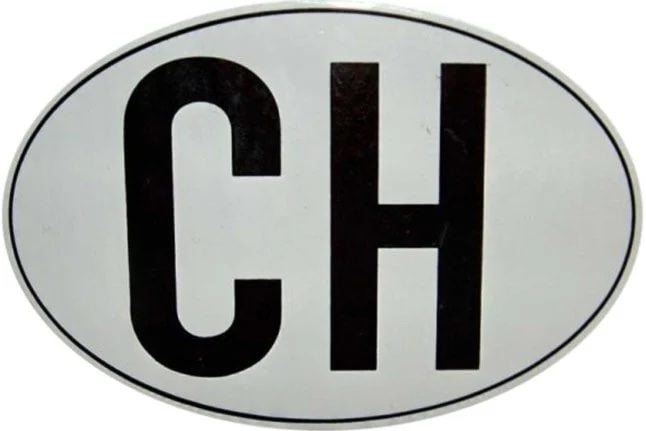You may be surprised to learn (or perhaps not, as this is Switzerland, where there is law for practically everything), that the CH sticker is a requirement, not an option.
Article 45 of the OETV (Ordinance concerning the technical requirements for road vehicles) clearly states that all motor vehicles must display the oval, black-and-white sticker when leaving their home territory.
According to this legislation, all vehicles, including motorcycles, trucks, and trailers traveling abroad “must bear a distinctive sign of nationality, i.e. the CH sticker, clearly visible on the rear of the vehicle”.
In other words, just as you must have a proof of your nationality when you leave the country, so must your car. Just be thankful that your passport or ID card are carried in your hand and not affixed to your rear.
To be clear, this legislation applies only to cars that travel abroad; if you never leave Switzerland at all, the sticker is not a requirement.
Actually, to be fair, the Swiss can’t be blamed entirely for this rule.
This obligation stems from the Vienna Convention on Road Traffic, passed in 1968, which Switzerland has also ratified.
“This international treaty provides for the possibility of integrating the distinctive sign of nationality into the registration plate”, according to Touring Club Suisse (TCS) motoring organisation.
It appears, for reasons we are not privy to, that the red cross that is embossed onto all plates “does not meet the requirements of the Convention, so it is not recognised as a distinctive sign”, TCS added.
Therefore, “the CH sticker remains compulsory”.
READ MORE: Why does Switzerland use ‘CH’ and what does it mean?
What format should the sticker have?
This is what the law says:
- Height x width of the oval: 11.5 x 17.5 cm
- Height x width of the letters: 8 x 4 cm
- Line thickness: 1 cm
This means the smaller versions of the sticker that you sometimes see on cars are not compliant.

Your car’s ‘passport’. Image: Wikicommons.
What about the placement?
This too is regulated by law:
It must be affixed at the rear of the vehicle, horizontally to its main axis, between 20 cm and 1.50 m from the ground, depending on the type of vehicle.
It must also be clearly legible and unobstructed.
An important point to keep in mind is that while you yourself may have two passports, your car cannot be a dual national and have other stickers. If it resides permanently in Switzerland, it should bear the CH sign only.
READ MORE: EXPLAINED: How visitors to Switzerland can avoid driving penalties
Where can you purchase these stickers?
They can be bought for about 5 francs in a variety of places, such as petrol service stations, motoring sections of hardware stores like Hornbach and Jumbo, or do-it-yourself sections of Coop and Migros.
What are the fines for driving without a sticker abroad?
There is no official data about this, but according to TCS, “we know of people who have been fined during their stay abroad for the absence of a distinctive sign on the back of their vehicle. Complying with the law therefore makes it possible to avoid unpleasant surprises abroad”.
Is the CH sticker the only one required to be affixed to a Swiss car?
For foreign travel, yes.
But if you drive on Switzerland’s motorways, you must have a ‘ vignette’ on your windshield. It costs 40 francs.
The vignette must be replaced each year from January 1st, whereas the CH sticker is valid for life — the car’s, not yours.
READ MORE: Swiss vignette: What you need to know about Switzerland’s motorway charge sticker



 Please whitelist us to continue reading.
Please whitelist us to continue reading.
Member comments